Fruit Flies
Jofré Barud F, Gómez MP, Ruiz MJ, Bachmann GE, Goane L, Segura DF, Lara, N, Murúa, F, ..., & López ML. 2023
Sexual competitiveness of sterile Ceratitis capitata males exposed to essential oils from non-host plant species native to Argentina.
Entomologia Experimentalis et Applicata 171, 146-155.
The sterile insect technique (SIT) is used to control fruit fly pests, such as the Mediterranean fruit fly (medfly), Ceratitis capitata(Wiedemann) (Diptera: Tephritidae). Enhancing sexual competitiveness of mass-reared sterile males can contribute to making this technique more effective. It has been shown that exposure to volatiles from essential oils (EOs), such as ginger root oil (GRO) and those from host fruits, increases male mating success. We evaluated the effect of EOs from non-host species native to Argentina, Schinus polygama (Cav.) Cabrera (Anacardiaceae) and Baccharis spartioides (Hook. & Arn.) Remy (Asteraceae), on the sexual competitiveness of sterile C. capitata males. In field cage experiments, sterile males exposed to S. polygama EO increased their mating success. In addition, sterile males exposed to this EO achieved more matings on trees than non-exposed males, thus suggesting the former are more prone to locate and defend the pheromone-calling territory. Deprivation of water and/or food significantly reduced males' life span, but exposure to S. polygama EO and GRO did not affect their survival. Schinus polygama EO is composed of mono- and sesquiterpenes with behavioral and electroantennographic responses in medflies, indicating that semiochemicals that boost medfly sexual competitiveness combine in this EO.
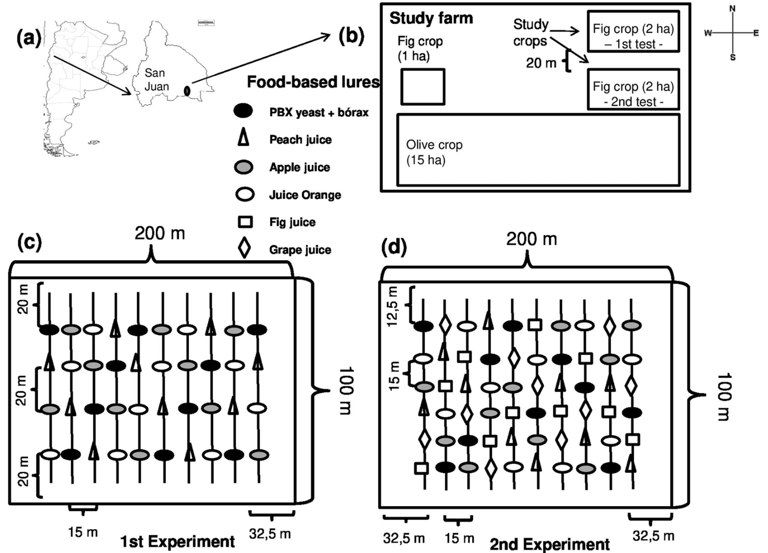

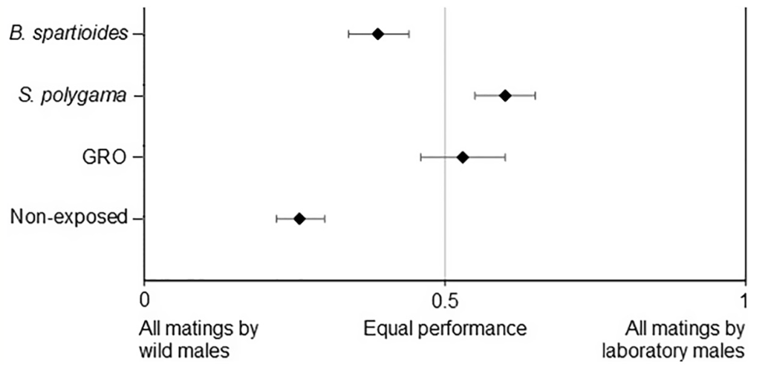

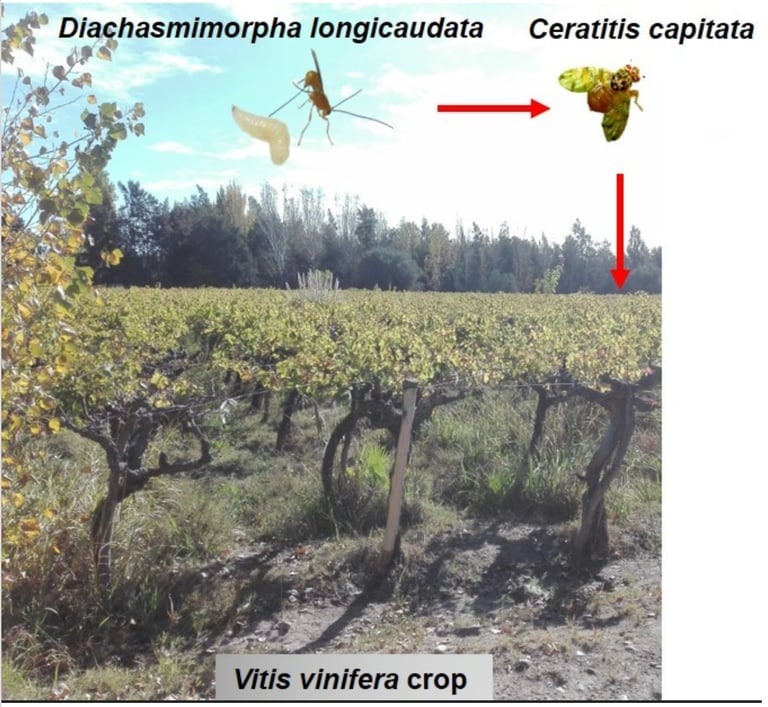

Suárez L, Buonocore Biancheri MJ, Díaz Nieto LM, Schliserman P, Murúa F, Rull J, ..., & Ovruski SM. 2023
Dynamic seasonal response of Ceratitis capitata (Diptera: Tephritidae) to fruit juice-based lures in fig orchards.
International Journal of Pest Management 69, 346-358.
Ceratitis capitata is the most serious agricultural pest in Argentinean fruit-growing regions. The use of baited traps for medfly control is an expanding and increasingly successful integrated management strategy. The high cost of traps and attractants is one of the main limitations for use on either a massive scale or a small-scale control. This study aimed to evaluate the advantages or disadvantages of using natural fruit juice-based lures for medfly adult monitoring at the orchard level in an irrigated valley. Medfly capture with a standard protein attractant was compared with peach, apple, sweet orange, fig, and grape juices. All attractants were evaluated in 1.5-liter disposable plastic bottles that served as traps. The most relevant finding was the interaction between attractant effectiveness and season. While the standard yeast was the most effective attractant during summer, the highest medfly caught values recorded during both spring and autumn were achieved with traps baited with orange juice. The use of fruit juices as attractants and disposable bottles as traps can decrease the impact on non-target insects and reduce management costs.
Rull J, Lasa R, Suárez L, Díaz Nieto LM, & Ovruski SM. 2022
Dynamic tephritid fruit fly response to olfactory and visual cues and the importance of foraging behavior for trap design and use.
In: Studies of Fruit Flies and their Behaviors. Mello Garcia F M (ed). Hauppauge, NY: Nova Science; 73-86.
Foraging behavior can be defined as a set of conducts by which an organism finds and acquires nutrients, egg-laying sites, or mates. It has therefore an important influence on the fitness of the forager and consequently it is the target of selection and often very plastic. Tephritid fruit flies find and use resources and mates by engaging in a sequence of behavioral events which are governed by olfactory, visual and tactile cues. Response to those cues depends on genotype, physiological state, experience, and environmental conditions. Foraging behavior has been exploited for the development of fruit fly traps. Natural and synthetic odors have been used for long distance attraction and visual cues have been exploited to develop effective trapping devices. Nevertheless, given the complex nature of foraging behavior and the numerous factors that can influence this trait, trap efficiency can also be dynamic, and efficient pest control and interpretation of monitoring results have to take into account the larger environmental and historical context in which trap captures occur. Additionally, identification of attractive volatiles and visual cues for the design of effective traps has to take into consideration the existence of competing natural stimuli that vary according to seasonal phenology. Here we overview, tephritid fruit fly foraging behavior in the context of trap design and use and attempt to illustrate the complexity of tephritid trapping with some examples of its dynamics. Our goal is to illustrate that efficient tephritid trapping requires in-depth knowledge of foraging behavior, this being key for the development of sustainable fruit fly management for pest control.
Suárez L, Buonocore Biancheri MJ, Murúa F, Ordano M, Wang X, Cancino J, ..., & Ovruski SM. 2023
Medfly population suppression through augmentative release of an introduced parasitoid in an irrigated multi-fruit orchard of central-western Argentina.
Insects 14, 387.
Ceratitis capitata, commonly known as the Mediterranean fruit fly or medfly, is one of the most damaging invasive insect pests for fruit production and trade worldwide. Augmentative biological control (ABC) using parasitoids, insects whose larvae develop as parasites that eventually kill their hosts, is an eco-friendly strategy for medfly suppression and is used in several countries. This strategy relies on periodic releases of large numbers of mass reared parasitoids in an area where naturally occurring parasitoids are too few to control the target pest. ABC has been incorporated for 10 years into medfly suppression strategies in the irrigated fruit production valleys of San Juan province, northwestern Argentina, by the San Juan Fruit Fly Control and Eradication Program. In this study, we report the results of mass releases of the Southeast Asia-native parasitoid Diachasmimorpha longicaudata in a fruit farm from early summer (December) to mid-autumn (May) over two successive years. The effect of the released parasitoids on the suppression of the medfly population was evaluated based on captures of adult flies in food-baited traps, and the resultant levels of parasitism of fly larvae were assessed based on adult flies in sentinel fruit traps. Our results showed a substantial decrease in the medfly population on the parasitoid release farm. Therefore, ABC can be an effective tool for medfly control in San Juan.
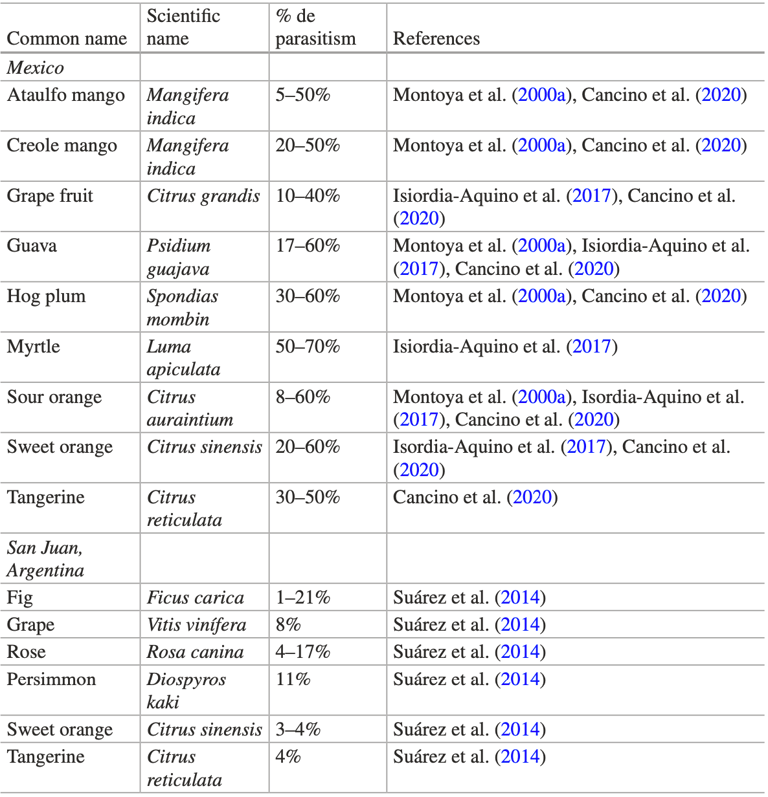


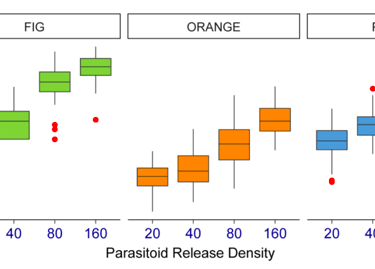
Suárez L, Núñez-Campero SR, Murúa F, Mello García FR, & Ovruski SM. 2024
Effectiveness of Diachasmimorpha longicaudata in killing Ceratitis capitata larvae infesting commercial fruits in dryland agroecosystems of western Argentina.
Agronomy 14: 2418.
Ceratitis capitata (Wiedemann) (medfly) strongly affects Argentinean fruit production and export. Augmentative biological control using the exotic parasitoid Diachasmimorpha longicaudata (Ashmead) is currently applied to this problem. The ability to find and parasitize medfly larvae on a wide diversity of fruit host species is a key issue that needs to be analyzed. This research assessed the effect of the physical features of fruit on the preference of foraging D. longicaudata females and the influence of varying release density on parasitoid performance as a pest mortality factor in three fruit species. Trials were performed inside field cages under semi-arid environmental conditions in Argentina’s central-western fruit-growing region. Sweet orange, peach, and fig were tested. The fruits were inoculated with third-instar larvae of the Vienna-8 temperature-sensitive lethal medfly strain. Naïve, 5 d-old mated D. longicaudata females were released in cages at 20, 40, 80, and 160 parasitoid densities. The highest levels of medfly mortality and parasitoid emergence were recorded in fig and peach, although D. longicaudata also induced mortality in orange, a fruit with few physical features favorable to parasitism. The medfly mortality in all fruit host species significantly increased with an increased number of parasitoid females released into the field cages. Diachsmimorpha longicaudata has high potential as a medfly biocontrol agent.
Suárez L, Buonocore-Biancheri MJ, Murúa AF, Beltrachini S, Kulichevsky LE, & Ovruski SM. 2024
Management of tephritid fruit flies in Argentina.
In: Mello García FR (ed) Management of Fruit Flies in the Americas. Springer, Cham; pp 169-195.
The Medfly, Ceratitis capitata (Wiedemann), and the South American Fruit Fly, Anastrepha fraterculus (Wiedemann), are the only economically important tephritid fruit fly species found in Argentina. Both species harshly affect production, marketing, and export of fruit and vegetable owing to their damage incidence and economic losses and their quarantine restrictions. The exotic species C. capitata is distributed throughout Argentina, while the native A. fraterculus is restricted to Northern Region. Since 1994 in Argentina, the National Agri-Food and Animal Health and Quality Service (SENASA) has implemented the National Fruit Fly Control and Eradication Program (PROCEM). The first fruit fly control strategy applied through PROCEM has been based on the integrated use of the sterile insect technique (SIT), cultural and air/ground chemical controls, and a quarantine system. Nowadays in the Patagonia and Cuyo regions, fruit fly area-wide integrated management led to the establishment of Medfly free areas and reduction of postharvest treatments. Augmentative biological control in central-western Argentina was currently added into biorational strategies of PROCEM-San Juan as a complementary tool in environmentally friendly way. This chapter reviews the current threat status of fruit fly pests in Argentina by reporting on the progress in their manage- ment and emphasizing control strategies that should be deepened.
Cancino J, Suárez L, Ayala A, Buonocore-Biancheri MJ, Murúa AF, & Ovruski SM. 2024
Augmentative biological control as a workable strategy within an area-wide integrated fruit fly management approach: Case studies from Mexico and Argentina.
In: Mello García FR (ed) Management of Fruit Flies in the Americas. Springer, Cham; pp 197-220.
Augmentative release of parasitoids is a suitable strategy to control fruit fly populations. Parasitoid release is relevant because it may be used strategically to integrate with other control methods. Augmentative Biological Control (ABC) aims to release high densities of mass produced into an area to suppress the population growth rate of the target fruit fly species. In Latin America, there are several examples of ABC against Ceratitis capitata (Wiedemann) and against species of the Neotropical genus Anastrepha Schiner. The introduced parasitoid Diachasmimorpha longicaudata (Ashmead) is the main species used in ABC programs. Successful outcomes have been achieved in Mexico and central-western Argentina by D. longicaudata mass releases. I n “BioPlanta San Juan,” Argentina, D. longicaudata is mass reared on larvae of C. capitata Vienna-8 (tsl) strain. This parasitoid is released in irrigated semiarid fruit-growing valleys. On the contrary to Mexico, D. longicaudata is mass produced on larvae of Anastrepha ludens (Loew) at the biofactory of the Fruit Fly National Program to release it over larger subtropical areas. Post-release data have shown higher values than 50 % of host mortality. This chapter provides particular information on the use of biological control, within the area-wide program in environmentally distinguishable regions. Advantages, social problems, and their relation with costs are also discussed.
Guillemain MJ, Díaz Nieto LM, Suárez L, Rull J, Ovruski S, Acosta JC, ..., & Murúa F. 2021
Offseason medfly trapping using makeshift fruit-based and wine vinegar baits.
Neotropical Entomology 50, 289-297.
Abraham S, Díaz V, Moyano A, Castillo G, Rull J, Suárez L, Murúa A F, ..., & Ovruski S M. 2021
Irradiation dose does not affect male reproductive organ size, sperm storage, and female remating propensity in Ceratitis capitata.
Bulletin of Entomological Research 111, 82-90.
Suárez L, Buonocore Biancheri MJ, Sánchez G, Cancino J, Murúa F, Bilbao M, ..., & Ovruski SM. 2020
Radiation on medfly larvae of tsl Vienna-8 genetic sexing strain displays reduced parasitoid encapsulation in mass-reared Diachasmimorpha longicaudata (Hymenoptera: Braconidae).
Journal of Economic Entomology 113, 1134-1144.
Núñez-Campero SR, Suárez L, Buonocore Biancheri MJ, Cancino J, Murúa F, Molina D, ..., & Ovruski SM. 2020
Host suitability and fitness-related parameters in Coptera haywardi (Hymenoptera: Diapriidae) reared on irradiated Ceratitis capitata (Diptera: Tephritidae) pupae stemming from the tsl Vienna-8 genetic sexing strain.
Journal of Economic Entomology 113, 1666-1674.
Gadea SLC, Suárez L, Buonocore Biancheri MJ, Murúa F, Molina D, Laría O, & Ovruski SM. 2020
Effects of exposure time and ratio of irradiated larvae from three medfly strains on progeny yield in Diachasmimorpha longicaudata (Hymenoptera: Braconidae) mass rearing.
Biocontrol Science and Technology 30, 592-601.
Suárez L, Buonocore Biancheri MJ, Sánchez G, Murúa F, Funes CF, Kirschbaum DS, ..., & Ovruski SM. 2019.
Effects of releasing two Diachasmimorpha longicaudata population lines for the control of Ceratitis capitata infesting three key host fruit species.
Biological Control 133, 58-65.
Suárez L, Buonocore Biancheri MJ, Murúa F, Rull J, Ovruski S, de los Ríos C, ..., & Schliserman P. 2019
An egg-laying device to estimate the induction of sterility in Ceratitis capitata (Diptera: Tephritidae) sterile insect technique programmes.
Journal of Applied Entomology 143, 144-154.
Suárez L, Buonocore Biancheri MJ, Murúa F, Bilbao M, García M, Cancino J, ..., & Ovruski SM. 2019
Effects of host age and radiation dose in Diachasmimorpha longicaudata (Hymenoptera: Braconidae) mass-reared on medfly larvae of the tsl Vienna 8 genetic sexing strain.
Biological Control 130, 51-59.
Suárez L, Buonocore Biancheri MJ, Sánchez G, Murúa F, Funes CF, Kirschbaum DS, …, & Ovruski SM. 2019
Desempeño de Diachasmimorpha longicaudata (Hymenoptera: Braconidae) criado masivamente sobre la cepa de sexado genético tsl Vienna-8 de Ceratitis capitata (Diptera: Tephritidae) y liberado contra Anastrepha fraterculus (Diptera: Tephritidae) en condiciones de semi-campo [Performance of Diachasmimorpha longicaudata (Hymenoptera: Braconidae) mass-reared on the genetic sexing strain tsl Vienna-8 of Ceratitis capitata (Diptera: Tephritidae) and released against Anastrepha fraterculus (Diptera: Tephritidae) under semi-field conditions].
Revista de la Facultad de Agronomía de la Universidad Nacional de La Pampa 29 (Suppl.), 34-35.
Sánchez G, Murúa F, Suárez L, Van Nieuwenhove G, Taret G, Pantano V, ..., & Ovruski SM. 2016
Augmentative releases of Diachasmimorpha longicaudata (Hymenoptera: Braconidae) for Ceratitis capitata (Diptera: Tephritidae) control in a fruit-growing region of Argentina.
Biological Control 103, 101-107.
Suárez L, Murúa F, Lara N, Escobar JM, Taret G, Rubio JL, …, Ovruski SM. 2014
Biological control of Ceratitis capitata (Diptera: Tephritidae) in Argentina: Releases of Diachasmimorpha longicaudata(Hymenoptera: Braconidae) in fruit-producing semi-arid areas of San Juan.
Natural Science 6, 664-675.
Murúa F, Suárez L, Taret G, Sánchez G, García M, Bilbao M, ..., & Ovruski SM. 2013
Avances en el desarrollo del control biológico mediante el empleo del parasitoide Diachasmimorpha longicaudatad(Hymenoptera: Braconidae) en un programa de manejo integrado de omoscas de la fruta en San Juan [Advances in the development of biological control using Diachasmimorpha longicaudata (Hymenoptera: Braconidae) in a fruit fly integrated management program in San Juan Province].
Acta Zoologica Lilloana 57, 46-47.
Suárez L, Van Nieuwenhove GA, Murúa F, Bezdjian LP, Schliserman P, Lara N, ..., & Ovruski SM. 2012
Offspring production in response to host exposure times in Diachasmimorpha longicaudata (Hymenoptera: Braconidae), reared on the genetic sexing strain Vienna 8 of Ceratitis capitata (Diptera: Tephritidae).
Florida Entomologist 95, 991-999.
Suárez L del C, Murúa AF, Acosta JC, Moyano BL, & Escobar JM. 2009
Evaluacion en campo de la capacidad atrayente des esferas de agar coloreadas para la oviposicion de Ceratitis capitata Wiedemann (Diptera: Tephritidae) [Field evaluation of the attactiveness of coloured agar spheres for the oviposition of Ceratitis capitata Wiedemann (Diptera: Tephritidae)].
Boletín de la Sociedad Entomológica Aragonesa 45, 562-564.
Díaz LM, Murúa FA, Acosta JC, & Escobar JM. 2008
Capacidad dispersiva de Ceratitis capitata (Diptera: Tephritidae) entre valles agricolas en San Juan, Argentina [Dispersal behaviour of Ceratitis capitata (Diptera: Tephritidae) among agricultural valleys in San Juan, Argentina].
Revista de la Sociedad Entomologica Argentina 67, 155-161.